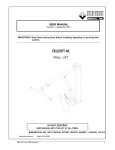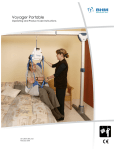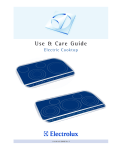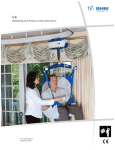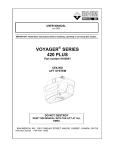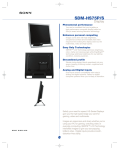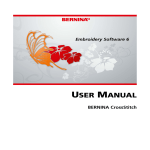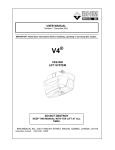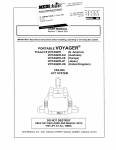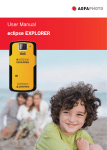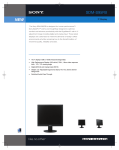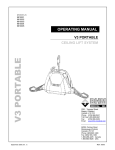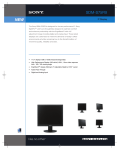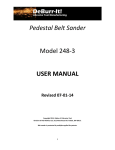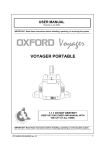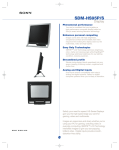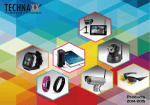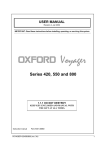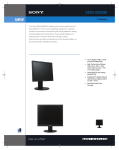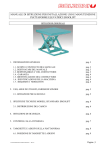Download ERGOLIFT-2 ERGOLIFT
Transcript
USER MANUAL Revision 2, August 2001 IMPORTANT: Read these instructions before installing, operating, or servicing this system. ERGOLIFT-2 ERGOLIFT-600 and ERGOSTAND MOBILE PATIENT LIFT Product numbers as above, please add the following after part # if other than N. America: UK= United Kingdom – CE= Europe – JP= Japan – AU= Australia DO NOT DESTROY KEEP MANUAL WITH THE LIFT AT ALL TIMES. BHM MEDICAL INC., 2001 TANGUAY STREET, MAGOG, QUÉBEC, CANADA, JIX 5Y5 Instruction manual Ergolift-Ergostand rev. 2 Part # 001.06100 BHM Medical Inc. designs and manufactures quality engineered patient lifting equipment for the care of the disabled in hospitals, nursing homes and home care. Please take the time to read the entire manual, including the section on "Safety Instructions and Warnings". It contains important information that will allow you to take advantage of all the characteristics of your BHM patient lift. BHM Medical Inc. Credentials • FDA Registration # 9681684 • CE mark (European Union Listing) • Global Operations for in-warranty and out-of-warranty service support for all patient lifts. • Each finished Ergolift/Ergostand is individually tested in our laboratory. • Lifting Capacity 180 kg/400 lbs. to 270 kg/600 lbs. Engineering safety factor exceeds European Standards. • Complete range of patient lift slings and supports designed and manufactured by BHM Medical Inc. using medical quality materials and fabrics. • ISO 9001 APPROVALS: CSA 601.1 UL 2601.1 EN 60601.1 EN ISO 10535 (Lifting device) SGS UK Test Report: DUR22107/AC/OO Note: BHM Medical is constantly improving its products. For this reason, it may be possible to encounter a modification of product without revision of this manual. Thank you for trusting your BHM Medical Partners. How to contact us: North America : BHM Medical Inc. 2001 Tanguay Street Magog (Québec) Canada J1X 5Y5 Phone: (819) 868-0441 service calls during business hours - extension #109 (8:00-12:00 and 1:00-5:00 p.m. E.S.T.) service calls outside regular business hours extension #6199 (you must press the pound key) Fax : (819) 868-2249 Web site :www.bhm-medical.com Email: [email protected] Ergolift-Ergostand rev. 2 2 TABLE OF CONTENTS INTRODUCTION ........................................................................................................................................ 4 HOW TO USE THIS MANUAL ........................................................................................................................ 4 EQUIPMENT IDENTIFICATION....................................................................................................................... 4 RECEIPT OF EQUIPMENT .............................................................................................................................. 4 KEY TO SYMBOLS ....................................................................................................................................... 4 SAFETY INSTRUCTIONS AND WARNINGS ........................................................................................ 5 DESCRIPTION OF EQUIPMENT ............................................................................................................ 7 ERGOLIFT, ERGOLIFT 600. .......................................................................................................................... 7 ERGOSTAND ................................................................................................................................................ 7 OPERATION................................................................................................................................................ 8 HOW TO USE THE ERGOLIFT, ERGOLIFT-600 AND ERGOSTAND ................................................................... 8 EMERGENCY STOP FEATURE ........................................................................................................................ 9 BATTERY INFORMATION ........................................................................................................................... 11 CHARGING THE BATTERY .......................................................................................................................... 11 BHM ERGOFIT SLING............................................................................................................................ 12 HAMMOCK SLING ...................................................................................................................................... 13 SLING PLACEMENT - FROM CHAIR OR WHEELCHAIR ................................................................................. 13 SLING ATTACHMENT OPTIONS .................................................................................................................. 14 QUICK-FIT SLING ...................................................................................................................................... 17 HYGIENIC SLING ....................................................................................................................................... 19 WALKING SLING ....................................................................................................................................... 21 BAND SLING .............................................................................................................................................. 22 SLING INSPECTION AND CARE ................................................................................................................... 24 MAINTENANCE ....................................................................................................................................... 26 DAILY CHECKLIST..................................................................................................................................... 26 INSPECTION AND CLEANING ...................................................................................................................... 26 HANDLING AND STORAGE ......................................................................................................................... 26 BATTERY REPLACEMENT .......................................................................................................................... 26 CHARGER FUSE REPLACEMENT ................................................................................................................. 28 BOOM ACTUATOR REPLACEMENT ............................................................................................................. 29 BASE ACTUATOR REPLACEMENT .............................................................................................................. 29 LUBRICATION & CASTERS ......................................................................................................................... 30 CLEANING OF CASTERS.............................................................................................................................. 30 ANNUAL INSPECTION ................................................................................................................................ 31 MAINTENANCE INSPECTION CHECKLIST ..................................................................................... 32 TROUBLESHOOTING............................................................................................................................. 35 ACCESSORIES.......................................................................................................................................... 36 LOG BOOK ................................................................................................................................................ 37 WARRANTY .............................................................................................................................................. 40 Ergolift-Ergostand rev. 2 3 INTRODUCTION INTRODUCTION How to Use this Manual DO NOT ATTEMPT TO USE THIS EQUIPMENT WITHOUT UNDERSTANDING THIS MANUAL. To ensure safe operation, read carefully the entire manual, especially the section on “Safety Instructions and Warnings”, before installing, operating, or servicing this equipment. If anything is not completely understood, please contact your supplier for more details. Failure to comply with warnings in this manual may result in injury. Keep this manual with the lift and refer to it as required. Contents of this manual are subjected to change without prior notice to users. Throughout this manual, the following symbols may appear. Pay particular attention to the information provided under these headings. These special annotations are easily recognized as follows: WARNING : this symbol is intended to alert the user to hazards or unsafe practices which could result in serious bodily harm. CAUTION: this symbol is intended to alert the user of the presence of important operating and maintenance instructions which could prevent product damage or possible personal injury. Equipment Identification The unit's identification number (specification, model, serial number) appears on a silver nameplate attached to the back of base. Receipt of Equipment Upon receipt of the equipment, verify it against the packing list to ensure it is complete and inspect the equipment for possible damage due to shipping. If there is any damage, DO NOT use the equipment and notify the carrier immediately to file a claim. Provide complete information concerning damage claims or shipping errors to your supplier. Include all equipment identification numbers and group part numbers (if any) as described above along with a full description of damaged parts. Key to Symbols The following symbols are used on lifter’s attachment labels: This symbol is required to be displayed on regulated products for sale in the European Market. It indicates that the product complies with applicable European Directives related to health, safety, environment and consumer protection. SWL Safe Working Load represents the maximum load the lifter is rated for safe operation. The following symbols are used on sling labels and related to washing instructions: 60ºC Maximum washing temperature (140°F) permanent cycle. 60°C Do not use bleach. Do not dry clean. NOTE: this symbol offers helpful information concerning certain operating procedures. Additional copies of this manual can be purchased by contacting your supplier. Include the User Manual product number and equipment identification numbers. Ergolift-Ergostand rev. 2 Tumble dry low temperature. Do not iron. Please refer to individual sling labels for complete instructions regarding washing and drying. 4 SAFETY INSTRUCTIONS AND WARNINGS SAFETY INSTRUCTIONS AND WARNINGS A. GENERAL ¾ IMPORTANT – READ CAREFULLY THESE INSTRUCTIONS OR SERIOUS INJURY MAY RESULT. ¾ KEEP THESE INSTRUCTIONS WITH THE LIFT AT ALL TIMES. ¾ READ OPERATING MAINTENANCE INSTRUCTIONS IN INSTALLING, OPERATING, OR SERVICING THIS EQUIPMENT. ¾ YOUR LIFT is for transferring patients only. Do not use the lift for any other purpose. ¾ ALWAYS carry out the daily check list before using the lift. ¾ BHM Medical mobile floor lifts are specifically designed for BHM Medical slings and accessories. Slings and accessories designed by any other manufacturer is prohibited and will void BHM Medical’s warranty. Use only BHM Medical slings and accessories to maintain patient safety and product utility. ¾ BHM Medical mobile floor lifts are intended to be used for patients within the specified weight limit indicated for the lift. Do not attempt to lift more than the weight limit indicated. ¾ BEFORE attempting to transfer, the patient must be assessed by a qualified professional. ¾ BHM Medical mobile patient lifts must be used by a caregiver with proper training to work with the patient to be transferred. ¾ ONLY trained and qualified caregivers should transfer a patient. DO NOT attempt to use the lift if you have not been properly trained to do so. ¾ ALWAYS be prepared before attempting to transfer a patient. ¾ DO NOT use a sling that is not recommended for the lift. ¾ NEVER use a damaged, torn or frayed sling. ¾ ALWAYS place the sling around the patient according to the instructions enclosed. ¾ FOLLOW lifting procedures outlined in this manual. ¾ USE all controls and safety features only according to the rules specified in this manual. Never attempt to force a control or button on the lift. ¾ DO NOT store the lift in a shower, bath or other area with high humidity. ¾ IMPORTANT: Keep all components of the lift clean and dry, and have electrical and mechanical safety checkpoints done as instructed in the "Maintenance" section of this manual. ¾ REPLACE any precautionary or instruction labels that cannot be easily read. ¾ DO NOT attempt to manoeuvre the lift by pushing on the mast, motor shaft, boom or patient. ¾ ALWAYS manoeuvre the lift with the handle provided. ¾ DO NOT push a loaded lift at speeds which exceed a slow walking pace (3 kilometers/hour or 0.8 meters/second) ¾ DO NOT push the lift over uneven or rough ground, particularly if loaded. ¾ DO NOT attempt to push or pull a loaded lift over a floor obstruction which the casters are unable to ride over easily. ¾ DO NOT BUMP the lift down steps, loaded or unloaded. ¾ DO NOT park a loaded lift on any sloping surface. Ergolift-Ergostand rev. 2 THIS MANUAL BEFORE 5 SAFETY INSTRUCTIONS AND WARNINGS A. GENERAL (continued) ¾ DO NOT use an electric lift in a shower. ¾ The BHM Mobile floor lift is not intended to be a transport device. The BHM Mobile floor lift should not be used to transport a patient over any long distance. ¾ BASE should be opened as much as possible for optimum safety. ¾ DO NOT USE, in any way, the actuator as a handle to push or pull the lift. If the actuator is used as a handle, the caregiver and the patient safety is greatly compromised. B. SHOCK PREVENTION ¾ AVOID violent shock during transportation. ¾ DO NOT touch or use a lift with bare conductors or a damaged power cord. Electrically live equipment can electrocute a patient. If the lift or charger has any exposed or damaged wires contact your local dealer immediately. ¾ DO NOT cut or remove the round grounding prong from any plug. All BHM lifts are equipped with three-prong plugs to protect from shock hazard or electrocution. Any two pronged electrical outlet must be replaced with a properly grounded three-prong outlet according to the National Electrical Code and local codes. It is the responsibility of the customer to have the work done by a qualified electrician. ¾ DO NOT splash or expose electric parts of the device to water or moisture. ¾ CHECK nameplate for voltage and cycle requirements. These requirements differ by country. Do not attempt to use the lift in an area that has a different voltage and cycle requirements. ¾ READ the battery and charger instructions thoroughly before using or storing them. C. FIRE AND EXPLOSION ¾ Batteries may explode, leak and cause personal injury if not disposed of properly • • • • • ¾ Do not place or store the battery under direct sunlight or near a heat source Do not dispose of in fire Do not short the battery terminals Do not incinerate Flush with water if electrolyte (Acid) comes in contact with skin or eyes. Batteries must be recycled or disposed of according to local law regulations. When returning batteries, insulate their terminals with adhesive tape, etc. Otherwise the residual electricity in used batteries may cause fire or explosion. D. EQUIPMENT WARNING LABELS ¾ Inspect all precautionary labels on the equipment. Order and replace all labels that cannot be easily read. Ergolift-Ergostand rev. 2 6 DESCRIPTION OF EQUIPMENT DESCRIPTION OF EQUIPMENT Ergolift, Ergolift 600. THE LIFT IS HEAVY AND MUST BE REMOVED FROM THE CRATE WITH ASSISTANCE AND CARE. • • • • • • • • • • • • • • • • • • Capacity of over 100 lifts with fully charged batteries. Limit switches at each end of the actuator spindle that stops the actuator when fully extended and retracted. Anti-crush device on the actuator that stops the actuator from retracting when it is obstructed. Motorized adjustable base. Anti-sway device on the carry bar – Ergolift & Ergolift 600 only. Padded carry bar with easy to use locking hooks. Room under the boom that allows the patient to rotate 360 degrees without touching the motor or any part of the lifter. Multi-purpose handle for easy use by users with different heights. Easy to access emergency stop. Minimum height is low enough to lift a patient lying on the floor without lifting the shoulders. Directional wheel guide on one of the rear casters that allows the user to move the lifter in a straight line. For more liberty of movement, the handset can be placed on the multi-purpose handle or at the end of the mast. Low battery charging light indicator on the control box. Extra controls on the control box allows use of the lift if handset becomes damaged. Power cord’s hook placed at the same height as the handle (no need to bend to plug it). Hospital grade power cord. The whole unit complies with CSA No. 601.1, UL No. 2601-1 and CE standards. Maximum capacity of Ergolift, 400 lbs (180 kg) – Ergolift 600 lbs (270 kg). Ergostand • • • • • • • • • • • • • Ergolift-Ergostand rev. 2 Maximum capacity of 400 lbs (180 kg) Capacity of over 100 lifts with a fully charged batteries. Limit switches at each end of the actuator spindle that stops the actuator when fully extended and retracted. Anti-crush device on the actuator that stops the actuator from retracting when it is obstructed. Multi-purpose handle easy to use by different size users. Easy to access emergency stop. Directional wheel guide device on one of the rear casters that allows the user to move the lifter in a straight line. For more liberty of movement, the handset can be installed on the multi-purpose handle or at the end of the mast. Integrated battery charger. Low battery and charging light indicator on the control box. Extra controls on the control box allows use of the lift if handset becomes damaged. Power cord’s hook placed at the same height as the handle (no need to bend to plug it). Hospital grade power cord. 7 OPERATION • The hole unit comply with the CSA No. 601.1 and UL No. 2601-1 and has a CE certification. lower the lift so the carry bar is near the thorax, then install the straps. HAVE SOMEONE ASSIST YOU WHEN ATTEMPTING TO TRANSFER A PATIENT. MAKE SURE TO LOCK THE REAR WHEELS ON THE LIFT WHEN ATTEMPTING A TRANSFER. Attach the straps of the sling as described in the sling instructions of the manual. Make sure that all straps are secure to the carry bar. Carefully observe the patient’s safety as you lift the patient slightly by pressing the control button: OPERATION How to use the Ergolift, Ergolift600 and Ergostand READ CAREFULLY THE "SAFETY INSTRUCTIONS AND WARNINGS" SECTION BEFORE ATTEMPTING TO USE THE LIFT. Always carry out the daily checklist before each lift use. Unplug the lift from the electrical outlet. Install the patient sling (see sling installation) Open the base as wide as possible using the button on the handset or control box. Ergolift and Ergolift-600 only; (Ergostand instructions to follow) Raise / lower the boom (using the on the handset) so the carry bar is approximately chest height to the patient. Move the lift over to the patient, so the end of the boom is approximately 15 cm (6 inches) away from the patient. For a patient in a lying position, Ergolift-Ergostand rev. 2 BEFORE LIFTING THE PATIENT : 1. Make sure that all straps are attached to the carry bar. 2. Make sure the patient is comfortable. 3. Make sure the sling is not caught on an obstruction (wheelchair brake or arm of chair). If any of the above occur - Lower the patient immediately and correct the problem. Lift until the patient's buttocks clear the arm supports or the top of the bath or bed before moving the patient. Guide the legs past any obstacle. THE BHM MOBILE FLOOR LIFT IS NOT INTENDED TO BE A TRANSPORT DEVICE. PATIENT IN THE LIFT SHOULD NOT BE MOVED MORE THAN A FEW METERS (YARDS). DO NOT ATTEMPT TO MANOEUVRE THE LIFT BY PULLING ON THE MAST, BOOM, ACTUATOR OR PATIENT. When the patient is located above the desired point of transfer and ready to be lowered, press the button. Make sure wheels are locked on the bed or wheelchair. For a transfer into a seated position; use the handles on the back of the sling to position the patient when transferring into a chair. Hold the handles firmly as the sling lowers and the sling 8 OPERATION will tilt back to position the patient. As the boom lowers, guide the lift away from the patient (appro. 15 cm/6 inches). Once the patient is properly seated and the straps are loose, remove the sling from the lift. Slide the lift away from the patient. Sling may be removed from around the patient. Instructions for Ergostand BEFORE LIFTING THE PATIENT : 1. Make sure that all straps are attached to the carry bar. 2. Make sure the patient is comfortable. 3. The sling is not caught on an obstruction (wheelchair brake or arm of chair). If any of the above occur - Lower the patient immediately and correct the problem. 4. Lower the boom using the as low as possible. button so it is 5. Bring the lift towards the patient so that the foot rest of the Ergostand is right in front of the patient's feet. 6. Gently place the patient's feet on the foot rest so that the patient's heels are against the edge of the foot rest and push the lift until the patient's shins are in the pads. patient is able, holding on to the Ergostand arms. 9. Press the up button to raise the patient slightly. Check to make sure that there are no obstacles in the way. If you find that the sling has loosen a bit around the waist of the patient, tighten the belts around the patient’s waist. Once the patient is secure, continue to raise the patient until he/she is above the chair or toilet before moving to the next transfer point. THE BHM MOBILE FLOOR LIFT IS NOT INTENDED TO BE A TRANSPORT DEVICE. PATIENT IN THE LIFT SHOULD NOT BE MOVED MORE THAN A FEW METERS (YARDS) 10. Move the patient directly over the point of transfer, lock the wheels on the wheelchair or bed. When the patient is positioned against the chair or bed, lock the rear wheels on the Ergostand. 11. Slowly lower the patient by pressing the button. As you lower the patient, use the handles on the back of the sling to position the patient in the chair. 12. Lower the arms of the Ergostand so they are as far down as possible. 13. Remove the straps of the sling from the arms of the Ergostand. Lift the patient's feet off the foot rest and move the lift a few inches away from the patient. 14. Sling may be removed from around the patient. Emergency stop feature 1. The emergency stop feature stops the lift from functioning in case of an emergency. It does not affect the charging system, the lift will charge whether or not the emergency stop is engaged. 2. To activate the emergency stop, press down on the red button on top of the control box on the lift. 7. Lock the rear wheels on the Ergostand. 8. Place the sling loops on the knobs to the side of the Ergostand arms according to the instructions shown in the sling installation section of this manual. The patient's arms must be over top of the sling, and if the Ergolift-Ergostand rev. 2 9 OPERATION 3. To deactivate the emergency stop, turn the button clockwise. Move the patient over a bed or chair. Slowly pull upwards on the tab and hold in place until the patient is lowered onto chair or bed. Emergency Lowering Feature The Ergolift and Ergolift-600 have an emergency manual lowering feature in the event of an electrical or functional failure. If the lift malfunctions when a patient is being transferred, the emergency manual lowering device provides a safe way of lowering the patient onto a chair or bed. To operate the emergency lowering feature: Find the red tab on the side of the motor on the lift. Ergolift-Ergostand rev. 2 Once the patient is lowered safely into a chair or bed, take the lift to a certified technician to be serviced. Anti-crush feature To prevent damage or injury, the motor on the lift has a limit switch that recognizes when the boom is being lifted or pressed upward. This limit switch will stop the motor until the boom is no longer being lifted or pressed upward. This will ensure that the motor stops if the boom is unknowingly being lowered onto an object or patient. To check this feature, press the button on the handset or control box then lift up the boom. The motor should stop. 10 OPERATION Battery Information DO NOT DROP THE BATTERY. A DROPPED BATTERY MAY HAVE INTERNAL DAMAGE THAT IS NOT VISIBLE. IT MAY LOSE ITS ABILITY TO RECHARGE. Due to internal damage caused when the battery is dropped, the battery may indicate it is fully charged, when in fact it cannot hold a full charge. A green light indicated on the charger may not accurately reflect a full charge on a damaged battery. If you drain the battery until it beeps every time, you can expect the battery to fully charge only 300 times. To prolong battery life – Plug the unit in an outlet WHENEVER THE LIFT IS NOT IN USE. The battery will not overcharge. BHM uses sealed lead-acid batteries. Contrary to nickelcadmium, BHM batteries do not have any memory effect. Therefore, batteries should not be completely drained before recharging them. NEVER attempt to use a battery that appears to be damaged or dented. DO NOT store the battery near a heat source. Heat will damage it. Graph 2 Number of lifts vs. Lift load Always keep metal battery contacts clean. 24 Vdc, 7 Ah rechargeable battery. • Provides 80-100 transfers per battery charge (may vary depending on patient weight and battery condition. See graph below). Life cycle (number of charging cycles) of the battery is largely dependent on the depth of discharge in each cycle. The more the battery is drained, the shorter its life span. The life of the battery is also related to such factors as varying temperatures and rest periods between charge and discharge. Graph 1 - Number of recharge vs. Depth of discharge 120 100 100 % Capacity % 80 60 50% 40 30% 20 0 0 20 0 40 0 60 0 0 80 10 00 200 1 Charge/discharge cycles Graph 1 illustrates the relationship between discharging depth and expected battery life. If you use only 30% of the battery power between each charge, you can expect the battery to fully charge 1050 times. Ergolift-Ergostand rev. 2 Number of lift • 200 180 150 100 50 0 120 73 300 54 440 Weight (lbs) The above graph (Graph 2) illustrates the relationship between the load lifted and the number of lifts that can be done with one recharged battery span. Do not drain the battery excessively. This will dramatically reduce the battery life span. If the low battery buzzer sounds, be sure to recharge the battery as soon as possible. Charging the battery DO NOT OPERATE THE CHARGER UNIT WITH A DAMAGED CORD OR IF THE UNIT HAS BEEN DAMAGED. DO NOT forcibly bend the power cord or place a heavy object on it. This will damage the cord and may cause a fire or electrical shock. 11 SLINGS DO NOT place the unit in locations that are : • Extremely hot • Dusty or dirty • Very humid • Moving or vibrating The recharging steps should be as follows: (see step by step instructions ) PLEASE READ CAREFULLY THE FOLLOWING, BEFORE USING A BHM MEDICAL ERGOFIT SLING. ¾ ALWAYS CARRY OUT THE DAILY CHECK LIST BEFORE EACH LIFT USE. ¾ BHM MEDICAL FLOOR LIFTS ARE SPECIFICALLY DESIGNED FOR BHM MEDICAL SLINGS AND ACCESSORIES. SLINGS AND ACCESSORIES DESIGNED BY ANY OTHER MANUFACTURER ARE PROHIBITED AND WILL VOID BHM MEDICAL’S WARRANTY. USE ONLY BHM MEDICAL SLINGS AND ACCESSORIES TO MAINTAIN PATIENT SAFETY AND PRODUCT UTILITY. ¾ PATIENT TO BE TRANSFERRED MUST BE ASSESSED BY A QUALIFIED PROFESSIONAL BEFORE ATTEMPTING TO TRANSFER. Plug the power cord into a standard three-prong outlet. Check the charging indicator light to ensure that it is illuminated. When the battery is low, the low battery indicator should emit an audible intermittent beep and the red light should be illuminated. Observe a trained expert to perform the transfer procedures and then practice them several times with a capable individual acting as patient before attempting a transfer with a patient with limited capabilities. Leave the unit plugged in. At minimum, charge the battery until the light is green before using it again. This will extend the life of the battery. Charger Specifications: • Hospital grade charger cord and plug. Charger input: 120 Vac, 60 Hz, 0.5 A. (North America) / 240 Vac, 50 Hz, 0.25 A (European). BHM ERGOFIT SLING Every patient has different needs. It is very important to choose the right sling based on the needs of the patient to be transferred as well as their physical ability and size. All BHM slings are made from a Polyester/ Nylon material, which is soft and pliable, easy to care for, and install. All slings are machine wash and dry in medium temperature. BHM slings are covered by a one-year warranty. Ergolift-Ergostand rev. 2 ¾ READ CAREFULLY ALL INSTRUCTIONS BELOW BEFORE ATTEMPTING TO INSTALL A SLING. ¾ IF YOU HAVE ANY DOUBTS, PLEASE CONTACT YOUR REPRESENTATIVE. LOCAL Before transferring a patient from a stationary object (wheelchair, bath or bed), slightly raise the patient off the stationary object and check that all sling attachments are secure. If any attachment is not correct, lower the patient and correct the problem, then raise the patient and check again. ¾ USE A SLING RECOMMENDED BY THE PATIENT’S PHYSICIAN, NURSE OR MEDICAL SPECIALIST AS APPROPRIATE FOR THE PATIENT’S ABILITY AND NEEDS. DO NOT use any kind of plastic backed incontinence pad or seating cushion between the patient and sling material. That may cause the patient to slide out of the sling during a transfer. 12 SLINGS DO NOT exceed the maximum weight limitation of the sling. ¾ WHENEVER POSSIBLE, HAVE SOMEONE ASSIST YOU TO ENSURE THE PATIENT’S SAFETY AT ALL TIMES. Laundry Instructions for all slings: The following symbols are used on sling labels and related to washing instructions: 60ºC Hammock 6 Strap Sling (THA6-S,M,L) Almost identical to the Hammock sling above, this sling provides extra security and a tighter fit for patients who are low-tone or who would prefer a more secure feeling. The head support is tighter and the extra straps on the side provide more lateral support. The patient may be transferred in a seated, semi-reclined or fully reclined position. Fits all BHM ceiling lift models as well as the Ergolift mobile lift. Available in sizes S, M, L. Weight capacity 250 Kg (550 lbs.) Maximum washing temperature 60°C (140°F) permanent cycle. Do not use bleach. Do not dry clean. Tumble dry low temperature. Do not iron. SLING SIZES AND PRODUCT NUMBERS: Approximate weight: User instructions for: Hammock Sling Inspect each sling for wear, tears or loose stitching after each wash. Hammock Sling (THA-S,M,L) Our most universal sling, the Hammock sling is a mesh type material that dries quickly but is soft and pliable. The sling has an incorporated head support and a unique strap system that keeps the patient secure in the sling. A special polyester fabric in the seat area helps to reduce friction and makes the sling easy to place around a patient in a chair without lifting or remove the patient. The patient may be transferred in a seated, semi-reclined or fully reclined position. Best choice for most situations – including bathing. Fits all BHM ceiling lift models as well as the Ergolift Mobile Lift. Available in sizes S, M, L. Weight capacity 250 Kg (550 lbs.) Approximate height: Color Code Hammock Product # Hammock 6 Product # SMALL 20-46 kg (45-100 lbs.) 120-150 cm (4’4’11”’) Red THA-S MEDIUM 46-95 kg (100-210 lbs.) 151-180 cm (5’-5’11”) LARGE 95-250 kg (210-550 lbs.) 181 cm + (6’ +) Yellow THA-M Green THA-L THA6-S THA6-M THA6-L Sling Placement - from Chair or Wheelchair 1. Sling has two sides, the white fabric indicates the side that is intended to be next to the patient, the label and colored handles are on the outside. The top of the sling is slightly rounded and the bottom of the it has a U-shaped design. (U-shape and white fabric) Ergolift-Ergostand rev. 2 13 SLINGS 2. Lean the patient forward in the chair and make sure that the patient is supported. Whenever possible have someone assist you to ensure the patient's safety at all times. 3. With the white fabric of the sling facing the patient, grab the sling at the top of the Ushape and slide the sling down to the base of the spine or coccyx. hand on the patient’s knee to hold it in place and gently pull the sling forward with the other hand until the edge of the sling is approximately even with the patient’s knee. 7. Place the patient’s foot on your thigh and slide the white section of the sling under the leg. 7. Repeat steps 5 & 6 for the other leg. 4. Tuck the sling down on each side to make sure that it is just slightly under the patient’s buttocks. Check for the stitching of the sling handle at the center to make sure that it is in line with the patient’s spine and bring the patient to the back of the chair or wheelchair. Sling Attachment Options Option 1 - Bridge (most recommended) a) Take the two straps between the legs – these are the short loops – and thread one loop through the other to cross them. 6. Kneel in front of the patient so that your back is straight and so you are at eye level with your patient. Grab the end of the sling with the white fabric and make sure there are no twists in the sling. Make sure the white fabric is facing the patient’s leg. Place one Ergolift-Ergostand rev. 2 14 SLINGS b) Now take the long strap on the outside of each leg and string it through the inside strap. By crossing the straps as you see here, form a bridge above the patient’s legs and protect them from any pinching or pressure, as well as keep the knees and hips in line. c) Place the hands inside the sling. See sling placement for leg separation as installed below. Finally, place the patient’s hands inside the sling. OPTION 2 – Leg Separation Using this method of sling placement will pull the patient’s legs apart. Check with the patient’s physician, nurse or medical specialist before attempting this method. a) Thread the long strap through the short strap on each leg. b) Each short strap should be attached to the long strap on the same leg. Ergolift-Ergostand rev. 2 15 SLINGS OPTION 3 – Amputee Do not use this method of sling placement for a patient who is agitated or spastic. a) Slide the sling end with the white fabric so that it is all the way under both legs. One sling strap will be on top of the other. When transferring a patient from a bed, have people on each side of it, or raise the bed rails to ensure the patient does not roll off the bed. b) Thread the long strap through the short strap that is next to it. The photo below shows clearly an example without a patient in it . 2. With someone there to assist you, carefully roll the patient onto one side. Now place the fold of the sling at the center of the bed or where the spine of the patient will be. The top of the U-shape in the sling should be at the base of the spine or coccyx .The top of the sling should be next to the head. Lift the top fold and tuck next to the patient. c) When installed there should not be any sling material between the patient’s legs. Place the hands inside the sling. Sling Placement- from lying position 1. Fold the sling in half lengthwise with the white part of the sling on the inside of the fold and place next to the patient to be transferred. Ergolift-Ergostand rev. 2 16 SLINGS 3. Lower the patient down on top of the sling. Roll the patient the opposite direction to pull the sling out the other side. Always use the same color loop on the rear shoulder straps for both sides of the sling. Use the same color loop on the leg straps for both sides of the sling. 4. Place the straps in the same way as shown from a seated position for the hammock sling. Use the same color loop on the hip straps for both sides of the Hammock 6 strap sling. 3. Ensure the patient’s arms are inside the sling and that it is not caught on any obstructions (eg. Wheelchair brake or handle). 4. See Lift Instructions for next step. User Instructions for: Quick-Fit Sling Sling attachment to Carry Bar 1. Ensure the sling is properly placed around the patient according to the instructions above. 2. Choose the color of the loop you will need for the position you will be placing the patient in. If transferring to a seated position, use the loops indicating it. Ergolift-Ergostand rev. 2 Specially designed for patients who are stocky or obese, especially in the midsection. Padding around the buttocks and leg area helps to provide extra support. Upper portion of the sling is a mesh type material that dries quickly but is soft and pliable. This sling does not provide head support. The patient may be lifted in a seated, semi-reclined or fully reclined position. Fits all BHM ceiling lift models as well as the Ergolift mobile lift. Available in sizes S, M, L. Weight capacity 250 kg (550 lbs.) Do not use the Quick-Fit sling on a patient who cannot support their own head. 17 SLINGS make sure that it is in line with the patient’s spine and bring the patient to the back of the chair. SLING SIZES AND PRODUCT NUMBERS: Approximate weight: Approximate height: Color Code Quick-fit SMALL 20-46 kg (45-100 lbs.) 120-150 cm (4’4’11”’) Red TIR-S MEDIUM 46-95 kg (100-210 lbs.) 151-180 cm (5’5’11”) Yellow TIR-M LARGE 95-250 kg (210-550 lbs.) 181 cm + (6’ +) 4. Kneel in front of the patient so that your back is straight and so you are at eye level with your patient. Grab the end of the sling with the white fabric and make sure there are no twists in the sling. The white fabric should be facing the patient’s leg. Place one hand on the patient’s knee to hold it in place and gently pull the sling forward with the other hand until the edge of the sling is approximately even with the patient’s knee. Green TIR-L Sling Placement - from Chair or Wheelchair Whenever possible have someone assist you to ensure the patient's safety at all times. 1. Sling has two sides, the white fabric indicates the side that is intended to be next to the patient, the label and colored handles are on the outside. The top of the sling is straight and the bottom of the sling has a Ushaped design. 2. Lean patient forward in the chair and make sure the patient is supported. 5. Place the patient’s foot on your thigh and slide the white section of the sling under the leg. 6. Take the two straps between the legs. There is a small loop on each strap right next to the sling. Thread one strap through the other to cross them. 7. By crossing the straps as you see here, we keep the knees and hips in line. 3. With the white fabric of the sling facing the patient, grab the sling at the top of the Ushape and slide it down to the base of the spine or coccyx. Tuck the sling down on each side to make sure that it is just slightly under the patient’s buttocks. Check the seam for the sling handle at the center to Ergolift-Ergostand rev. 2 18 SLINGS middle of the thigh. The padding wraps around the patient’s midsection and under each leg. In order to use this sling, the patient must have good muscle-tone in their shoulders and upper body. Fits all BHM ceiling lift models as well as the Ergolift mobile lift and Ergostand standassist. Available in sizes S, M, L. Weight capacity 250 kg (550 lbs.) Do not use Hygienic sling on a patient who does not have good muscle-tone in their shoulders and neck. 8. Place the patient’s hands inside the sling before attaching it to the lift. Sling attachment to Carry Bar Check with the patient’s physician, nurse or medical specialist before using this sling. 1. Ensure the sling is properly placed around the patient according to the instructions above. 2. Choose the color of the loop you will need for the position you will be placing the patient in. If transferring to a seated position, use the loops indicated for a seated position. SLING SIZES AND PRODUCT NUMBERS SMALL CHEST SIZE 68-89 cm (27-35”) PRODUCT # THY-S COLOR Red CODE Always use the same color loop on the rear shoulder straps for both sides of the sling. Use the same color loop on the hip straps for both sides of the sling. MEDIUM 89-107 cm (35-42”) THY-M Yellow LARGE 107-125 cm (42-49”) THY-L Green 1. Sling has two sides, the white fabric indicates the side that is intended to be next to the patient, the label and colored handles are on the outside. The bottom of the sling has two long straps and the inside of the sling has a padded section with a belt. 3. Ensure the patient’s arms are inside the sling and that it is not caught on any obstructions (eg. Wheelchair brake or handle) 4. See Lift Instructions for next step. User Instructions for: Hygienic Sling This sling is excellent for changing incontinence pads or to transfer onto a toilet as it provides an open area from the middle of the back to the Ergolift-Ergostand rev. 2 19 SLINGS Whenever possible have someone assist you to ensure the patient's safety at all times. patient's foot on your thigh and slide the white section of the sling under the leg. 2. Lean patient forward in the chair and make sure the patient is supported. 3. With the white fabric of the sling facing the patient, place it approximately halfway down the back, or so the sling is below the shoulder blades. Lean the patient against the back of the chair. 7. The hygienic straps need not cross to allow better access to the toileting area. With the hygienic sling, the arms of the patient are always over top of the sling. Sling attachment to Carry Bar 1. Ensure the sling is properly placed around the patient according to the instructions above. 2. Choose the color of the loop for the position that is best suited for the patient. For a larger patient, choose blue for both the leg and shoulder straps. A smaller patient may be better suited for the black loops on both the shoulder and leg straps. 4. Fold the padded fabric waist band with the belt attached across the mid-section of the patient and clip the belt closed. Make sure the belt is secure. Always use the same color loop on the shoulder straps for both sides of the sling. 5. Tighten the belt until snug by pulling gently on the end of the belt. 6. Kneel in front of the patient so that your back is straight and so you are at eye level with the patient. Grab the end of the sling with the white fabric and make sure there are no twists in the sling. Make sure the white fabric is facing the patient's leg. Place the Ergolift-Ergostand rev. 2 Use the same color loop on the leg straps for both sides of the sling. 3. Ensure the patient’s arms are over top of the sling and that it is not caught on any obstructions (eg. Wheelchair brake or handle). 4. See Lift Instructions for next step. 20 SLINGS User Instructions for: Walking Sling Designed to assist people with limited ability to walk, this sling helps support and assist in rehabilitation. Fully padded with a security buckle, the sling is comfortable and simple to use. The user must have some weight bearing ability. Fits all BHM ceiling lift models as well as the Ergolift mobile lift. Available in sizes S, M, L. Weight capacity 250 Kg (550 lbs.) Do not use the Walking sling on a patient who does not have weight bearing ability and good muscletone in their shoulders and neck. Whenever possible, have someone assist you to ensure the patient's safety at all times. 2. Lean patient forward in the chair and make sure the patient is supported. 3. With the white fabric of the sling facing the patient, place the sling approximately halfway down the back, or so it is below the shoulder blades. Lean the patient against the back of the chair. Check with the patient's physician, nurse or medical specialist before using this sling. 4. Fold the padded fabric waist band with the belt attached across the mid-section of the patient and clip the belt closed. Make sure the belt is secure. SLING SIZES AND PRODUCT NUMBERS SMALL CHEST SIZE 68-89 cm (27-35”) PRODUCT # TEM-S COLOR Red CODE MEDIUM 89-107 cm (35-42”) TEM-M Yellow LARGE 107-125 cm (42-49”) TEM-L Green 1. Sling has two sides, the white fabric indicates the side that is intended to be next to the patient, the label and colored handles are on the outside. The bottom of the sling has two long straps and the inside of the sling has a padded waist section with a belt. Ergolift-Ergostand rev. 2 5. Tighten the belt until snug by pulling gently on the end of it. 21 SLINGS 6. Kneel in front of the patient so that your back is straight and so you are at eye level with the patient. Grab the end of the sling with the white fabric and make sure there are no twists in the sling. The white fabric should be facing the patient’s leg. Place the patient’s foot on your thigh and slide the white section of the sling under the leg. 9. Note that with the walking sling, the arms of the patient are always over top of the sling. Sling attachment to Carry Bar 1. Ensure the sling is properly placed around the patient according to the instructions above. 2. Adjusting the sling loops higher or lower in either the front or the back allows you to tilt the body either direction to correct posture. 7. The straps that come from between the legs do not attach to the lift. Thread the strap at the chest through the longest loop on the same side. Always use the same color loop on the rear shoulder straps for both sides of the sling. Use the same color loop on the chest straps for both sides of the sling. 3. Ensure the patient’s arms are over top of the sling and that it is not caught on any obstructions (eg. Wheelchair brake or handle). 4. See Lift Instructions for next step. 8. Repeat step 7 with the other side. 5. When raising the patient in the lift, check to make sure the sling sections between the legs are providing snug support. If there is not enough support, reinstall the sling threading the chest straps through a lower loop (grey or black). Repeat this step until the lower portion of the sling provides proper support. Band Sling (Use with Ergostand only) Ergolift-Ergostand rev. 2 This sling is specifically for the Ergostand mobile stand assist lift only. The use of this sling in conjunction with the Ergostand assists in changing incontinence pads or to transfer onto a toilet as it provides an open area from the middle of the back to the feet. The soft polyester nylon material is padded and quilted to add comfort. Strips sewn into the fabric in the back of the sling 22 SLINGS covers a wide area and distributes the weight evenly on the patient’s back and reduce pressure under the arms. PVC net material on the inside of the sling provides a grip that is soft to the touch, yet holds to the clothing of the patient. Additional padding under the arms reduces pressure and makes the sling very comfortable. Waist belt with velcro closure and belts makes the sling easy to adjust and secure around the patient In order to use this sling, the patient must have adequate muscle-tone in their shoulders and lower body. Fits only the Ergostand stand-assist. Available in sizes S, M, L, XL. Weight capacity 180 kg (400 lbs.) 3. With the white PVC material of the sling facing the patient, place the sling approximately halfway down the back, or so the sling is below the shoulder blades. Lean the patient against the back of the chair. Do not use the band sling on a patient who does not have good muscle-tone in their shoulders and neck. Check with the patient’s physician, nurse or medical specialist before using this sling. Band Sling numbers sizes and SMALL product MEDIUM CHEST SIZE 65-105 cm ( 26-42”) 75-110 cm (30-44”) PRODUCT # TST-S TST-M COLOR CODE Red Yellow LARGE X-LARGE CHEST SIZE 80-115 cm (32-46”) 85-120 cm (34-48") PRODUCT # TST-L TST-XL COLOR CODE Green Blue 4. Fold the fabric waist band with the velcro and belts attached across the mid-section of the patient. Velcro the belt into place, then clip the belts closed. Make sure the buckle is secure. 1. Sling has two sides, the white PVC material indicates the side that is intended to be next to the patient, the label and colored handles are on the outside. The top of the sling is rounded and the padding on the arm bands should be upward. The sling has a waist section with velcro and belts. Whenever possible have someone assist you to ensure the patient’s safety at all times. 2. Lean patient forward in the chair and make sure the patient is supported. Ergolift-Ergostand rev. 2 23 SLINGS 5. Tighten the belt until snug by pulling gently on the end of it. 3. Ensure the patient’s arms are over the sling and that the sling is not caught on any obstructions (eg. Wheelchair brake or handle). 4. See lift instructions for next step. Always use the same color loop on the shoulder straps for both sides of the sling. Sling attachement to the arms 1. Ensure the sling is properly placed around the patient according to the instructions above. 2. Choose the color of the loop for the position that is best suited for the patient. For a taller patient, choose yellow or red for both the shoulder straps. A shorter patient may be better suited for the blue or green loops on both the shoulder straps. Place the loop over each knob on the arm of the Ergostand. Ergolift-Ergostand rev. 2 Sling Inspection and Care For maximum patient safety and hygiene, read the following instructions: Chemical Attack Oil, grease, creosote or paint stains are harmless but other forms of chemical attack of a sufficient degree may lead to deterioration or extreme softening of the webbing, which would lead to the fibres being rubbed off (almost as powder in extreme cases). It is best to avoid fumes, spray or mists of acid and alkalis or organic solvents. If contamination is suspected, wash out well in warm water. Avoid contact with 24 SLINGS excessive heat which is likely to affect the product. Cleaning Certain chemical substances mentioned above may be removed by a diluted heavy duty cleaner and warm water. Ensure that any cleaning agents are removed by rinsing throughly in warm water, maximum 60°C (140°F), and allowed to dry naturally away from any source of direct heat. continuing to use the lift without changing the sling, caregiver and patient safety is greatly compromised. Take note of inspection results in the log book at the end of this manual. For normal washing and cleaning, follow the care instructions on the label of the product. Storage Slings should be stored sunlight, stress, pressure, humidity. The sling should contact with sharp objects, possible damaging material. away from direct excessive heat or be kept away from corrosives or other Daily Checklist 1. Check for any sign of wear on sling straps as described above and at the strap-sling junction. Buckles should be checked to ensure that the locking/unlocking mechanism opens and closes easily and is secure when locked. Loo se threa ds in stitc he d a re a. N otica ble disc oloratio n by h avin g a lighte r c olo r strap th an th e d ouble thickn ess stitc hed a rea . S ide w ear. M iddle w ea r. 2. Check for any sign of deterioration of the sling material. Check for general external wear, local abrasion, cuts, holes or burns in the webbing and for chemical attack. 3. Look at "stitched areas" for broken, worn, pulled or unravelled stitches. 4. Sling should be cleaned as indicated on the tag. 5. If there is any sign of wear or deterioration as indicated above or other visual defect, the sling should be changed immediately. By Ergolift-Ergostand rev. 2 25 MAINTENANCE MAINTENANCE ALWAYS CARRY OUT THE DAILY CHECKLIST BEFORE EACH LIFT USE. ERGOLIFT AND ERGOSTAND and accessories must be inspected ANNUALLY by a certified technician in addition to the daily and other periodic visual checks done by the user specified in this section. Preventive maintenance specified in this manual can prevent accidents and reduce repair costs. Note all services or repairs to the ERGOLIFT / ERGOSTAND or its accessories in the log book at the back of this manual. Have the document signed by a certified technician. Daily Checklist THE FOLLOWING PROCEDURE MUST BE FOLLOWED BEFORE EACH USE. • Has the battery been charged? Plug the lift in whenever is not in use. • Inspect the lift for any damage. If there are any cracks or other damage on the lift, or any parts are missing - DO NOT USE IT. Contact your local representative to have the lift serviced. • Inspect the carry bar for any signs of cracking or damage and that it rotates freely. • Inspect the actuator on the lift to ensure it is securely attached to the lift and has no visible damage. • Make sure casters roll freely and are securely attached. • Inspect the sling for tears, frayed straps or loose stitching. If the sling has any of the above damage – DO NOT USE IT. Contact your local representative to have the sling replaced or repaired. To ensure a better rolling surface for the wheels, clean THEM every 4 months. Remove any hair or debris from the wheel. To touch-up scratches or chipped paint and retard rust, apply white spray paint (BHM touchup paint product # P6111) Handling and Storage Avoid violent shock during transportation. The lift should not remain stored for long periods of time without recharging the batteries. BHM Medical recommends charging of batteries at least every two weeks even if the lift is not used. This will prevent premature aging of batteries. Battery Replacement BHM uses sealed lead-acid batteries. Contrary to nickel-cadmium, BHM batteries do not have any memory effect. Therefore, batteries should not be completely drained before recharge. Replace the battery if there is a noticeable reduction in the number of transfers that can be performed between charges. If you notice the low battery indicator light flashing and hear a “beep”. Plug the lift in for 2 hours or until the light turns green. DO NOT ATTEMPT TO USE A BATTERY NOT AUTHORIZED BY BHM MEDICAL. BHM batteries are specially designed for BHM charging systems. Attempting to use an unauthorized battery may seriously damage the lift and/or the charger. RECHARGE THE UNIT DAILY Inspection and Cleaning Clean the lift with a soft dry cloth, or a soft cloth lightly moistened with a mild detergent solution. Do not use any type of solvent that may damage the finish. DO NOT immerse the lift in water. Ergolift-Ergostand rev. 2 Battery Replacement (Ergolift – Ergostand) 1. Press the emergency stop button to ensure the lift will not accidentally operate while you are working on it. 2. Flip lift onto the mast access under the base. 26 MAINTENANCE 3. Unscrew the 7 bolts which hold the base cover (use a 8 mm socket) Remove the base cover. 4. Take out the actuator's two clevis pins and remove it from the base. 5. Disconnect batteries (little white connector) 5. Unscrew battery support brackets (8 mm socket). 6. Remove the battery. 7. Replace with new battery kit (product # A0150) and reconnect (little white connector). 9. Fasten battery supports (8mm socket). 10. Replace actuator, clevis pins and cotter pins. Follow proper direction (see drawing) Make sure the actuator wire is placed down next to the battery. 11. Replace the base cover. Important: Make sure the wires are out of the way and not squeezed. Ergolift-Ergostand rev. 2 27 MAINTENANCE Battery Replacement (Ergolift 600) 1. Press the red emergency stop button to ensure the lift will not accidentally operate while you are working on it. 2. Remove the cover on the base by unscrewing the 6 bolts (use a 8 mm socket). 7. Move the wires out of the way and replace the cover. Bolt on cover. Charger Fuse Replacement 1. If the charger light does not illuminate when the THE LIFT IS PLUGGED IN, do the following steps: 2. Check to make sure the power cord is correctly plugged into the charger and the wall. 3. If the light still does not work, plug the LIFT into a different outlet in a different area to ensure that the outlet is working properly. 3. Disconnect the clip for the battery wires. 4. Pull the power cord out of the charger. Under the socket for the power cord, there is a drawer or magazine where there are fuses. Using a pen or screwdriver, pull the drawer out gently. Pull the burnt fuse out of the drawer that is next to the charger (see diagram below) and discard it. Take the replacement fuse and place it in the same slot where the burnt fuse was. Slide the drawer back into the charger. Plug the power cord into the charger. Place the battery into the charger and check for the light. 4. Remove the batteries from their container. 5. If the light does not illuminate, contact your local dealer or representative for assistance. Replace the fuse with the following: Fuse: GMC 0.5A 250V North America (When input is 120 Vac) Product # C8FGMC0.5 GMC 0.25A 250V European (When input is 240Vac) Product # C8FGMC0.250 The fuse may also be ordered through your local dealer or representative. 5. Replace with new battery kit (product # A0150). 6. Clip together the battery wires. Ergolift-Ergostand rev. 2 28 MAINTENANCE Boom Actuator Replacement 1. Remove the bolt and plate (with phillips screwdriver) that secures the actuator power cord under the control box. the control box and secure it in place with the bolt and plate. Base Actuator Replacement 1. Press the emergency stop button to ensure the lift will not accidentally operate while you are working on it. 2. Ergolift and Ergostand - Flip the lift onto the mast to access under the base. 2. Remove the clevis pin from the actuator on the top and bottom of the actuator. Ergolift 600 only - Access the base through the top. 3. Remove the base cover by unscrewing the bolts with a 8 mm socket. 4. Remove the two clevis pins on each end of the damaged/inoperable motor. Ergolift and Ergostand 2. Replace the actuator with a new one (see replacement parts). Plug the actuator into Ergolift-Ergostand rev. 2 29 MAINTENANCE Ergolift-600 only: Take note of which hole the clevis pin was in and the direction of the motor to align the base properly. Refer to lubrication diagram for lubrication points. Lubricate all pivot points. Wipe all excess lubricate from lift surface. 1. 2. 3. 4. 5. Carry Bar Boom Mounting Bracket Boom / Mast Mount Mast Mounting Bracket Leg Pivots 5 Cleaning of casters 1. Place the lift on its side. 2. Remove the bolt and locknut that secure the existing front caster assembly to the fork. 3. Remove all debris and clean any dust. 5. Install the new motor into the lift in the same direction as the previous motor. 6. Replace the base cover and bolt on. 7. Release the emergency stop button by turning it clockwise. Lubrication & casters The lift is designed for minimum maintenance; however, a six (6) months check and lubrication should ensure continued safety and reliability. The casters MUST swivel and roll smoothly. A white grease (waterproof auto lubricant) may be applied to the ball bearing swivel of the casters once a year. Apply more frequently if the casters are exposed to extreme moist conditions. Ergolift-Ergostand rev. 2 30 MAINTENANCE For the front caster, examine and replace the existing washer if worn. The front caster assembly consists of two (2) washers and a caster in between. The caster will fall out between the two (2) washers. 3. Position the front caster in the assembly and tighten up the bolt and locknut. 4. Line up the mounting holes in the new front caster assembly and the fork 5. Install the bolt through the fork and caster assembly and thighten securely with the locknut. Annual Inspection The Ergolift, Ergolift 600 and the Ergostand and the accessories must be inspected annually by a certified technician. Ergolift, Ergolift 600, Ergostand and accessories must be serviced every 12 months as a minimum requirement. Do not attempt to do the inspection unless you are certified to do so. As part of the annual inspection, an annual load test with the safe working load must be performed on the ERGOLIFT, ERGOLIFT 600, AND ERGOSTAND as required for CE MARK MAINTENANCE. After annual inspection, have the log book signed by the certified technician. Ergolift-Ergostand rev. 2 31 MAINTENANCE INSPECTION CHECKLIST Maintenance Inspection Checklist TO BE INSPECTED BY USER ITEM INITIALLY BEFORE EVERY USE X X EVERY 2 EVERY 4 EVERY MONTHS MONTHS YEAR LIFT DEVICE Inspect for missing hardware or broken pieces. Battery recharge. X X X Overall inspection by authorized personnel. X SLINGS AND HARDWARE Check all sling attachments for sign of wear. X Inspect sling material for wear or deterioration. X Inspect sling straps for wear. X Inspect for any defect or loose threads in the "stitched areas". Cleaning sling as indicated on the tag. X When Necessary THE CASTER BASE Inspect for missing hardware X X Base opens/closes with ease X X Inspect casters and axle bolts for tightness X X Inspect caster for smooth swivel and roll X X Clean casters X THE MAST Mast MUST be securely assembled to boom. X X Inspect for cracks or deflections X X THE BOOM Check all hardware and swivel bar supports. X X Inspect for cracks or deflections. X X Inspect bolted joints of boom for wear. X X Inspect to ensure that the boom is centered between the base legs. X X Ergolift-Ergostand rev. 2 32 MAINTENANCE INSPECTION CHECKLIST INITIALLY ITEM BEFORE EVERY USE EVERY 2 EVERY 4 EVERY MONTHS MONTHS YEAR THE SWIVEL BAR Check the bolt / hooks for wear or damage X X Check sling hooks for wear or deflections X X THE MANUAL/HYDRAULIC / ELECTRIC ACTUATOR ASSEMBLY Inspect hardware on mast and boom X X Check for wear or deterioration. (IF DAMAGED, RETURN TO FACTORY) Cycle to ensure smooth quiet operation. X X X X A complete inspection of the actuator must be done by a certified technician X CLEANING Cleaning of the lifter X X For individual home use, a full inspection is required prior to each new user. Regular cleaning will reveal loose or worn parts, enhance smooth operation and extend the life expectancy of the lift. If applicable, an annual load test (maximum load) of Safe Working Load. Load is required for CE Mark Maintenance. Take note of inspection results in the log book at the end of this manual. MINOR SERVICE ITEM INITIALLY BEFORE EVERY USE EVERY 2 EVERY 6 EVERY MONTHS MONTHS YEAR General inspection of lifter X Check that casters are tightly attached to wheels X Check casters for free running wheels (remove any fluff and /or hair) Check that caster brakes operate efficiently X Overhaul casters and repack with all purpose grease X Inspect surfaces for scatches/chips X Ergolift-Ergostand rev. 2 X 33 MAINTENANCE INSPECTION CHECKLIST INITIALLY ITEM BEFORE EVERY USE EVERY 2 EVERY 6 EVERY MONTHS MONTHS YEAR Clean surfaces with mild soap and water and remove any adhesive tape marks with WD40 or other degreasing agent. Examine all moving parts and fasteners for wear fatigue and lubricate and/or adjust as required Arrange repair/replacement of any faulty parts X Check for signs or fatigue or cracks in the frame of the lift (especially joints and stress points) Retard rusting by applying with spray paint (BHM touch-Up Paint Product reference #P6111) Check boom/carry bar (hanger) X Keep a record of servicing along with signature of authorized service agent. Check all electrical components, including battery charges for correct operation. X X X X Always X MAJOR SERVICE (to be check by a certified technician, plus inspection of all of the above) Inspect the welding aspect on the frame to detect cracks. X Inspect connecting joints for proper attachment. X Verify emergency devices for good functioning. X Load test with the SWL (maximum working capacity). X Service motor X A major service undertaken by an authorized service agent every 12 months is a minimum requirement. Maintenance inspection points are suggested by the manufacturer and are a minimum requirement. By continuing to use the lift without replacing the listed parts in this maintenance inspection checklist, caregiver and patient safety is greatly compromised. Ergostand – Ergolift : Serial #ERLI-0000 to #ERLI-899 and ERST-000 to ERST-100 (LA32) motor (actuator) should be replaced every 5 years as a precautionary measure. Ergolift-Ergostand rev. 2 34 TROUBLESHOOTING TROUBLESHOOTING Only a certified technician is authorized to open the ERGOLIFT, ERGOLIFT 600 AND ERGOSTAND. Alterations made to the ERGOLIFT, ERGOLIFT 600 AND ERGOSTAND by someone other than a certified technician may cause serious injury. PROBLEMS TO CHECK The unit does not work when you press • Make sure the handset is plugged correctly into the unit. the up or down buttons on the handset. • Use the control switches directly on the unit. If they are working, it indicates a problem with the handset; you would then need to change the handset. The unit does not work when you press • Is the emergency stop button pressed down? Turn the the up or down buttons on the lift button clockwise to allow it to « pop » up. • Is the battery charged? • Plug the lift in and check the light on the control box. If the light remains red, leave the lift plugged in the control box for approximately 2 hours. • If all of the previous points have been checked without success, you probably have a motor or electric problem, you then need to call your BHM Medical representative. The unit starts and stops repetitively • If the load is more than safe working load, the unit will not work due to an overload protection on the motor. • Has the lift been making a “beeping” sound? The battery is low and needs to be charged. The lift emits a "beep" during utilization. • Batteries are low, recharge them. The unit may stop lifting but you can still lower it. Charge indicator on the control box • Is the charger plugged into a standard outlet? (green-red) does not light up when the • Check the condition of the fuse. If needed, change it with a battery is being charged. spare one. (see the “MAINTENANCE” section of this manual) Battery is always dead after a few • Replace battery with a new one, the life of the current one is transfers. (3 to 5) probably nearly over. (See the "BATTERY INFORMATION" section on page 11) The light on the control box shows • Replace the battery. green when the lift is plugged in yet the lift will only do one or two transfers. The light on the control box always • Call your dealer or representative. lights up red. It does not turn to green after an overnight charge Patient lift feels loose. (Mast/Base joint • Using a 5 mm allen key tighten the 2 bolts at base. loose) Casters/Brakes noisy or stiff (fluff or • Refer to casters in the "MAINTENANCE" section in this debris in bearings) manual. Noisy or dry sound from pivots (Needs • Refer to lubrication in the "MAINTENANCE" section in this lubrication) manual. Unusual noise from actuator (Actuator • Refer to "ELECTRIC ACTUATOR REPLACEMENT" in the is warn or damaged or sprindle is bent "MAINTENANCE" section of this manual. If problems are not resolved by the suggested means, please contact your dealer or BHM Medical Technical Service department. Ergolift-Ergostand rev. 2 35 ACCESSORIES ACCESSORIES ERGOSCALE Product No. ERGOSCALE-T2 SUPPORT FOR BARIATRIC SLINGS Product No. 700.05550 SUPPORT FOR STRETCHER SLING Product No. A5515 HOSPITAL GRADE POWER CORD Product No. E7525 North America E7521 Europe E7527 UK E7528 Australia HANDSET Product No.64800 FUSE Product No. C8FGMC0.5 (120 V) North America C8FGMC0.25 (240V) European Ergolift-Ergostand rev. 2 36 LOG BOOK LOG BOOK Product Name : ERGOLIFT - ERGOSTAND Product Serial Number : Date of purchase : Warranty Period : Distributed By : Owner Checklist : • • • • • Ensure the lift is serviced regularly as the maintenance inspection checklist on page 32. Contact an authorized BHM Medical Distributor / Service Agent immediatly if there are any problems with the operation of the device. Ensure the log book is completed and signed. Record any repairs required. Withdraw the patient lifter from service if inspection reveals that user safety is jeopardized in any way from use of the patient lifter. TO BE COMPLETE AFTER EACH SERVICE OR INSPECTION Service Type Pre-delivery Periodic inspection Minor Major Condition report : Action taken : Date : Inspected by: _________________ Service Type Pre-delivery ____________________ ____________________ Printed Signature Periodic inspection Minor Major Condition report : Action taken : Date : Inspected by: _________________ Ergolift-Ergostand rev. 2 ____________________ ____________________ Printed Signature 37 LOG BOOK Service Type Pre-delivery Periodic inspection Minor Major Condition report : Action taken : Date : Inspected by: _________________ Service Type Pre-delivery ____________________ ____________________ Printed Signature Periodic inspection Minor Major Condition report : Action taken : Date : Inspected by: _________________ Service Type Pre-delivery ____________________ ____________________ Printed Signature Periodic inspection Minor Major Condition report : Action taken : Date : Inspected by: _________________ Service Type Pre-delivery ____________________ ____________________ Printed Signature Periodic inspection Minor Major Condition report : Action taken Date : : Inspected by: _________________ Ergolift-Ergostand rev. 2 ____________________ ____________________ Printed Signature 38 LOG BOOK Service Type Pre-delivery Periodic inspection Minor Major Condition report : Action taken : Date : Inspected by: _________________ Service Type Pre-delivery ____________________ ____________________ Printed Signature Periodic inspection Minor Major Condition report : Action taken : Date : Inspected by: _________________ Service Type Pre-delivery ____________________ ____________________ Printed Signature Periodic inspection Minor Major Condition report : Action taken : Date : Inspected by: _________________ Service Type Pre-delivery ____________________ ____________________ Printed Signature Periodic inspection Minor Major Condition report : Action taken : Date : Inspected by: _________________ Ergolift-Ergostand rev. 2 ____________________ ____________________ Printed Signature 39 WARRANTY WARRANTY This warranty is extended only to the original purchaser/user of BHM products. BHM Medical Inc. warrants its products to be free from defects in material under normal use and service, within the periods stated below from the date of purchase. If within such warranty period any such product shall be proven to be defective, such product shall be repaired or replaced at BHM Medical’s option. This warranty does not include any labor or shipping charges incurred in replacement part installation or repair of any such product. BHM Medical’s sole obligation and your exclusive remedy under this warranty shall be limited to such repair and/or replacement. Patient Lifter including/Hydraulics Weighing Devices Accessories on Lifter Slings Batteries - Voyager Portable Batteries - All other lifts Easytrack System 1 year 1 year 1 year 1 year 3 months 1 year 1 year For warranty service, please contact the dealer from whom you purchased the BHM Medical product. [In the event that you do not receive satisfactory warranty service, please contact BHM Medical ( see contact information in Table of Contents).] Do not return products to our factory without prior authorization. BHM Medical will issue a Return Merchandise Authorization (RMA) Number. C.O.D. shipments will be refused; all shipments to BHM Medical must be prepaid. For this warranty to be valid, the purchaser must present its original proof of purchase at the moment of the claim. The defective unit, assembly or part must be returned to BHM Medical for inspection. The part or components repaired or replaced are guaranteed for the remaining period of the initial warranty. Limitations and Exclusions: The warranty above does not apply to serial numbered products if the serial number has been removed or defaced. No warranty claim shall apply where the product or any other part thereof has been altered, varied, modified, or damaged; either accidentally or through improper or negligent use and storage. Warranty does not apply to products modified without BHM Medical’s express written consent, (including but not limited to products modified with unauthorized parts or attachments); products damaged by reason of repairs made to any component without the specific consent of BHM Medical, or to products damaged by circumstances beyond BHM Medical’s control. Evaluation of warranty claim will be solely determined by BHM Medical. The warranty does not apply to problems arising from normal wear or failure to adhere to the instructions in this manual. BHM Medical Inc. slings are void of warranty if not laundered as per instructions on the Sling Label. BHM Medical Inc. shall not be liable for damages losses or inconveniences caused by a carrier. This warranty replaces any other warranty expressed or implicited and constitutes BHM Medical Inc.’s only obligation towards the purchaser. BHM Medical shall not be liable for any consequential or incidental damages whatsoever. Ergolift-Ergostand rev. 2 40








































